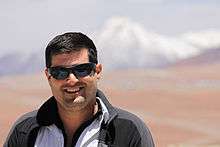Brian Keating
Brian G. Keating, born 1971, is a Distinguished Professor of Physics[1] [2] at the Center for Astrophysics & Space Sciences in the Department of Physics at University of California, San Diego[3][4]. He received his B.S. from Case Western Reserve University, M.S. from Brown University in 1995, and Ph.D. from Brown in 2000. He was a postdoctoral scholar at Stanford and a postdoctoral fellow at Caltech.
Brian G. Keating | |
|---|---|
 Brian Keating at the site of the POLARBEAR telescope at Cerro Toco, Chile, January 2012. |
Research
Keating's research area is the study of the cosmic microwave background and its relationship to the origin and evolution of the universe. In 2001 Keating conceived the first Cosmic Microwave Background (CMB) B-mode observing campaign, called BICEP (Background Imaging of Cosmic Extragalactic Polarization), located at the South Pole. In 2014 the BICEP2 successor project announced that it had found evidence of B-modes.[5][6][7] The BICEP2 experiment team received the 2010 NASA Group Achievement Award[8]. Keating is Co-Principal Investigator of the Simons Array, a Cosmic Microwave Background polarimetry experiment which consists of three POLARBEAR-2 type receivers located at the James Ax Observatory in the Atacama Desert in Chile. These are successor to the original POLARBEAR experiment which measured B-Modes in 2014.[9] In 2016, Keating became Director of the Simons Observatory, Cosmic Microwave Background experiment co-located near the Simons Array and ACT telescopes in northern Chile.[10] Groundbreaking for the Simons Observatory occurred on June 30, 2019 at its site in Chile[11]. The Simons Foundation and Heising-Simons Foundation have awarded a total of $80 million to the Simons Observatory, including $20 million for its operation phase beginning in 2022 [12]. The project includes over 250 collaborators from over 30 institutions around the world. Keating has expressed optimism that data from the Simons Observatory experiment may constrain the observed tension between low redshift and high redshift probes of the Hubble Constant[13].
Losing The Nobel Prize
Keating published the book Losing the Nobel Prize in 2018.[14] It describes the BICEP and BICEP2 experiments, located at the South Pole, devised to detect and map the polarization of the cosmic microwave background radiation leftover from the big bang. BICEP2's data showed strong polarization signals that were later shown to be caused by interstellar dust.[15] In the book, Keating argues that the Nobel Prizes in science have strayed from their original intent of Alfred Nobel's will, and may hinder scientific progress by fostering unnecessary, and sometimes destructive, competition by limiting credit to only 3 living individuals per prize.[16] Keating points out how the process of awarding Nobels has been biased against female and younger scientists.[17]
Recognition
In 2001, Brian Keating was selected as a National Science Foundation Astronomy and Astrophysics Postdoctoral Fellow[18]. In 2005, Keating received an NSF CAREER award for BICEP[19] . In 2006 he was awarded the Presidential Early Career Award for Scientists and Engineers by the National Science Foundation[20]. As part of the BICEP2 team, Keating received the 2010 NASA Group Achievement Award[21]. Keating received the Buchalter Cosmology Prize in 2014[22]. Keating is a Fellow of the American Physical Society[23], and an honorary member of the National Society of Black Physicists.[24]
References
- "Newsletter of the UCSD Division of Physical Sciences". The Starting Point. June 12, 2019.
- "List of Endowed Chairs at UC San Diego". List of Endowed Chairs at UC San Diego. July 12, 2019. Retrieved July 12, 2019.
- "UCSD Department of Physics Faculty Profile". UCSD Physics Department. Retrieved January 15, 2019.
- Johnson, Dana. "UCSD Center For Astrophysics and Space Science". UCSD Physics. Retrieved January 22, 2019.
- Reich, Eugenie Samuel (July 29, 2013). "Long-Predicted Polarization Detected in the Cosmic Microwave Background". Scientific American. Retrieved January 11, 2019.
- Klesman, Alison. "Writer". Astronomy. Kalmback Publishing Company. Retrieved 3 January 2019.
- Wolchover, Natalie (September 21, 2014). "'Big Bang Signal' Could All Be Dust". Quanta Magazine.
- "NASA Agency Honor Awards" (PDF). NASA.gov. May 11, 2010. Retrieved July 25, 2019.
- "POLARBEAR detects B-modes in the cosmic microwave background: Mapping cosmic structure, finding neutrino masses," Science Daily, Oct. 21, 2014
- Robbins, Gary. "Reporter". San Diego Union Tribune. San Diego Union-Tribune, LLC. Retrieved 3 January 2019.
- Fuller-Wright, Liz (July 10, 2019). "Simons Foundation commits $20 million in quest to understand universe's beginning". Princeton University. Retrieved August 12, 2019.
- Robbins, Gary (July 9, 2019). "UCSD gets $20M gift to operate Simons Observatory in Chile to explore early universe". San Diego Union Tribune. Retrieved July 12, 2019.
- Atlee, Jessica (July 9, 2019). "The 9 percent difference". Symmetry Magazine. Retrieved July 12, 2019.
- Mueck, Leonie (May 2, 2018). "The seduction of a scientist". Nature.com. Retrieved January 11, 2019.
- Halpern, Paul (April 16, 2018). "After dust stymies a quest to confirm cosmic inflation, a physicist questions science's most prestigious award". Science Magazine. Retrieved January 6, 2019.
- McKie, Robin (September 30, 2018). "Why Nobel Prizes Fail 21st Century Science". The Guardian. Retrieved January 11, 2019.
- Cowen, Ron. "The trouble with the Nobel prize". Nature. Springer Nature Publishing AG. Retrieved January 3, 2019.
- "NSF Astronomy and Astrophysics Postdoctoral Fellows". NSF Astronomy and Astrophysics Postdoctoral Fellows. Jan 1, 2001. Retrieved August 7, 2019.
- "The Birth Pangs of the Big Bang: Detecting Primordial Gravitational Waves with Microwave Background Imaging of Cosmic Extragalactic Polarization (BICEP)". National Science Foundation. March 4, 2006. Retrieved August 7, 2019.
- "National Science Foundation". National Science Foundation Awards. National Science Foundation. Retrieved 3 January 2019.
- "NASA Agency Honor Awards" (PDF). NASA. May 11, 2010. Retrieved August 7, 2019.
- Brown, Susan (January 6, 2015). "Cosmology Prize Recognizes 'Inventive' Proposed Test of Fundamental Physics". UCSD News. Retrieved January 11, 2019.
- "APS Fellow Archive". APS.org. American Physical Society. Retrieved 3 January 2019.
- Dillon, Cynthia (July 12, 2019). "A Rocket Man In His Own Right". UC San Diego Physical Sciences News.